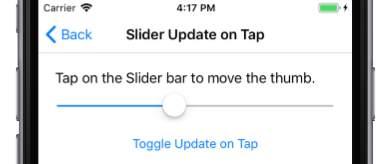Note
Access to this page requires authorization. You can try signing in or changing directories.
Access to this page requires authorization. You can try changing directories.
This iOS platform-specific enables the Slider.Value property to be set by tapping on a position on the Slider bar, rather than by having to drag the Slider thumb. It's consumed in XAML by setting the Slider.UpdateOnTap bindable property to true:
<ContentPage ...
xmlns:ios="clr-namespace:Xamarin.Forms.PlatformConfiguration.iOSSpecific;assembly=Xamarin.Forms.Core">
<StackLayout ...>
<Slider ... ios:Slider.UpdateOnTap="true" />
...
</StackLayout>
</ContentPage>
Alternatively, it can be consumed from C# using the fluent API:
using Xamarin.Forms.PlatformConfiguration;
using Xamarin.Forms.PlatformConfiguration.iOSSpecific;
...
var slider = new Xamarin.Forms.Slider();
slider.On<iOS>().SetUpdateOnTap(true);
The Slider.On<iOS> method specifies that this platform-specific will only run on iOS. The Slider.SetUpdateOnTap method, in the Xamarin.Forms.PlatformConfiguration.iOSSpecific namespace, is used to control whether a tap on the Slider bar will set the Slider.Value property. In addition, the Slider.GetUpdateOnTap method can be used to return whether a tap on the Slider bar will set the Slider.Value property.
The result is that a tap on the Slider bar can move the Slider thumb and set the Slider.Value property:
